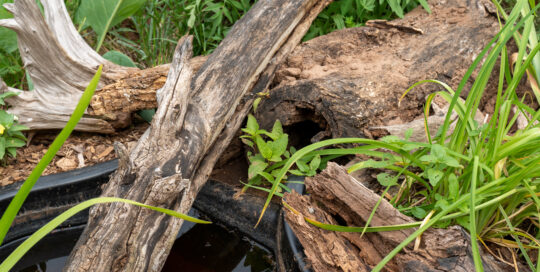Winning the Battle in the Gopher Wars
Views: 5759

We’ve received over four inches of rain in the last day or so, and my yard is thoroughly soaked. I stepped off my front patio, and my boot sank, ankle deep, into the soil. This is an area where I have gopher tunnels, and the soil is so saturated my weight collapsed the tunnels. In other places in the yard, the tunnels have washed out.
Pocket gophers (Geomys bursarius) have killed more plants in my yard than I care to think about. If I notice a plant dying unexpectedly, I always tamp down the ground around it to ensure it hasn’t fallen victim to someone tunneling underneath it.
It’s a battle – or war, really – that nearly brings me to tears at times. Bulbs disappear. Plants are destroyed, literally, overnight. In the heat of summer, my gophers seek out damp soil, so watering is a death sentence unless I water the lawn, too. I spend August watering both my plants and my gophers.
Now, I know most people would have resorted to extreme measures to ensure their gophers were eliminated long ago. Traps or poison would do the trick. Any pest control company would be happy to get rid of them for me. But poisoned animals can be toxic to anything that eats them, and I don’t want to risk anything that eats gophers, including my own or my neighbors’ dogs. And traps… they just aren’t for me.
Besides, the gophers were here when we moved in. It was their home before it was mine. They feed my hawks and, occasionally, my roadrunner, too. For the first several years we lived here, I kept hoping they’d attract a Barn Owl. (Barn Owls’ preferred food is gophers.) Last fall, finally, we heard one hooting in our yard. That alone made having gophers worthwhile.
Well, it helped, anyway.
I have learned, sort of, to live with gophers (and moles, too). I water my lawn so they don’t go for my flowerbeds. I’ve learned to enjoy the surprise of spring bulbs popping up in unexpected, sometimes awkward locations. I know the signs of an undermined plant. I’ve learned about gopher cages when planting trees, and gopher netting and gopher wire to protect beds (I haven’t resorted to using them, yet).
My Master Gardener classes discussed a variety of mole and gopher repellents. The takeaway was pretty much this: Sometimes they work; sometimes they don’t. I’ve personally had good luck with the repellents, both with moles and gophers. I applied a granulated gopher repellent last fall, and my beds have remained gopher-free since then. Gophers don’t hibernate for winter, and there was activity in other areas of the yard, but not in my flower beds. I plan to reapply after this rain. I think part of the trick is to keep reapplying it. Confining use to limited areas might help, as well.
Trying to coexist with gophers isn’t going to be for everyone. But if you don’t want to go with an all-out extermination effort, I think it’s worth giving repellents a try. Your local Barn Owls will thank you.
Meet Leslie Miller
Leslie Ann Miller shares 3.5 acres in rural Oklahoma with birds, butterflies and wide variety of animals. She is currently transforming her yard with plantings…
Leslie's Recent Posts

Creating microclimates and microhabitats to benefit wildlife






